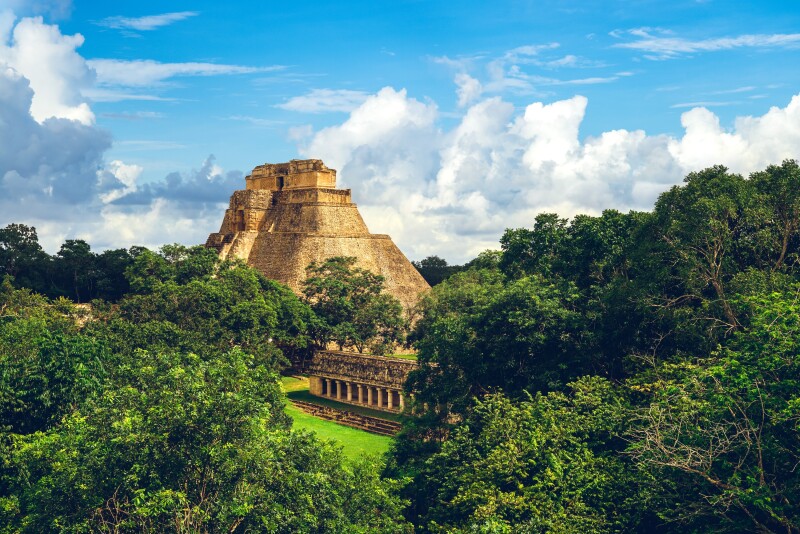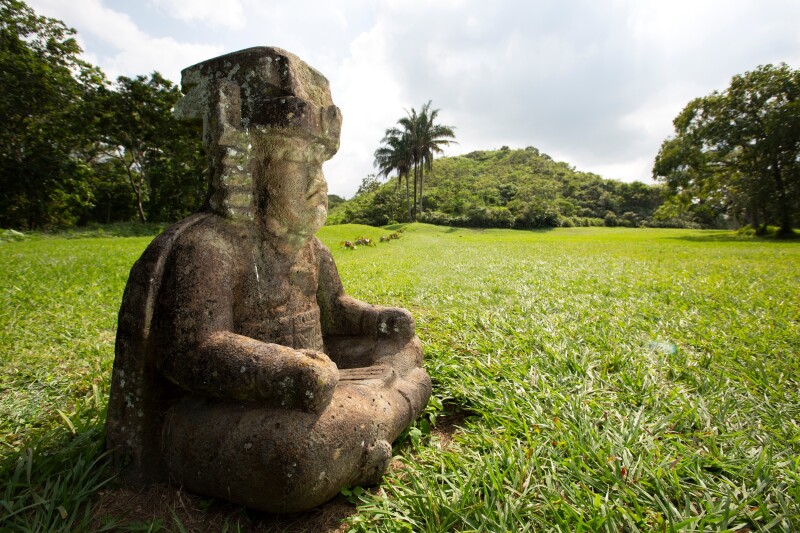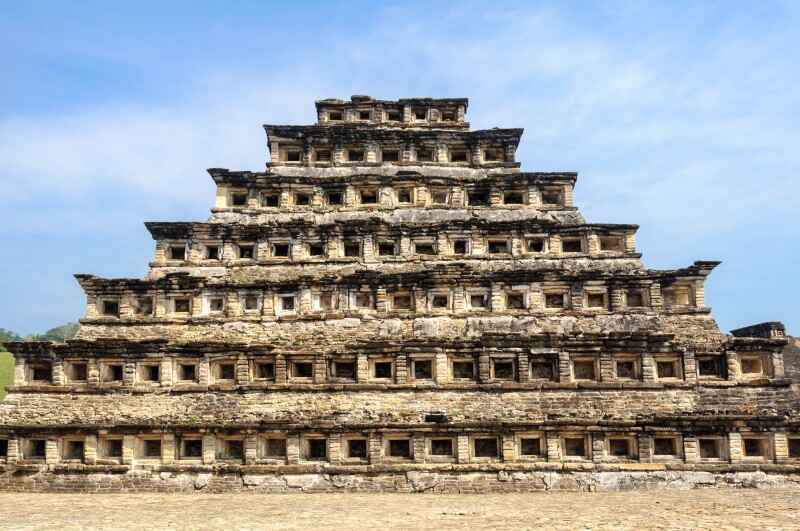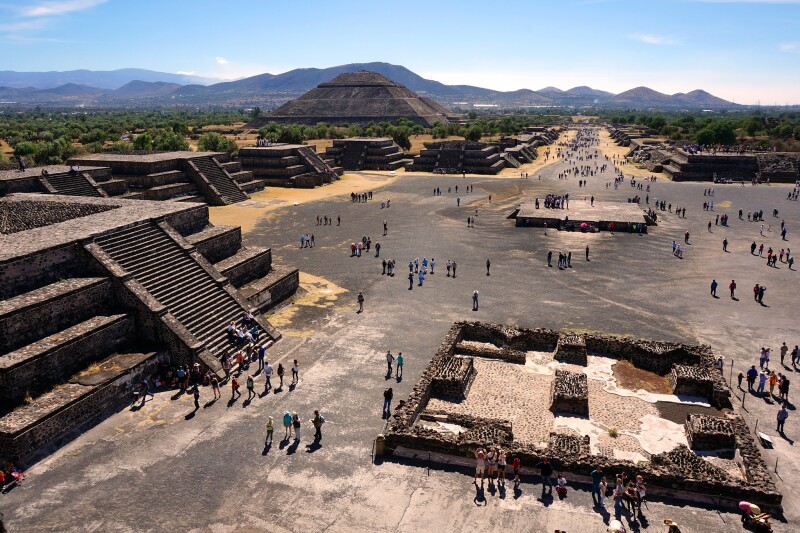There are plenty of wonders of the world to visit during your lifetime, but you only have to travel to the southern point of North America to find incredible historic architecture.
Mexico’s Maya and Aztec pyramids deserve a spot high on your travel list. These were once holy spaces for ancient civilizations, and each offers a moment of complete awe and a rare look into history.
The many pre-Columbian civilizations in Mexico—among them the Aztecs, Olmecs, Mayas, Mixtecs, Zapotecs, Tarascans, and Totonacs—shared a few common traits: Most of their archaeological sites include ball courts, they considered corn an essential crop, and they all built pyramids.
These civilizations’ handiwork appears throughout modern-day Mexico, providing a window into the country’s ancient past. Read on for what you need to know about Mexico’s famous pyramids, including 10 of the country’s most spectacular, culturally important ones.
(Note: Most of the archaeological sites below have little shade, so consider a morning visit, after which you can cool off in a cenote.)
How many pyramids are there in Mexico?
The short answer: nobody knows. Sadly, the pyramids in the Aztec capital of Tenochtitlán are long gone, but dozens of others across Mexico still stand.
Who built the pyramids in Mexico?
Pre-Columbian civilizations, such as the Olmecs and Zapotecs, created these impressive structures. For the most part, each civilization had a specific building style, although they all used materials like clay, stone, and mortar.
How old are the pyramids in Mexico?
The most significant pyramids were constructed over roughly two millennia, from around 900 B.C.E. to about 1000 C.E. These pyramids have survived thousands of years, but now they’re under threat—from climate change. Mexico’s National Institute of Anthropology and History reports that, in late July 2024, a pyramid on the Ihuatzio archaeological site in the state of Michoacán collapsed due to heavy rains preceded by high temperatures and ongoing drought, which caused cracks in the structure.
Where to find pyramids in Mexico

Map of the top 10 pyramids in Mexico to visit
Courtesy of Google Maps
The above map of Mexican pyramids shows several impressive ruins located along the country’s eastern coast. Others are clustered inland, around Mexico City and farther south in Oaxaca.
Here are 10 of our favorite pyramids to visit in Mexico.
1. Castillo de Kukulcán, Chichén Itzá (Yucatán)
The Castillo de Kukulcán, with its nine stepped platforms, is the centerpiece of Chichén Itzá, a Maya city that flourished from around 700 to 900 C.E. The pyramid functioned as an enormous calendar and was designed so that, on the equinoxes, the play of sunlight and shadow would create the illusion of a snake descending to Earth. While visitors are no longer allowed to climb the steps or access the Temple of Kukulcán at the top of the pyramid, they can tour other ball courts, temples, and palaces throughout Chichén Itzá.
How to visit
The roads to Chichén Itzá are safe and well-maintained, so you can drive yourself, take the bus, or go with a tour. Halfway between Cancún and Mérida (roughly two to three hours from either), this UNESCO World Heritage site is often crowded with tourists and vendors. The plus is that you can experience Chichén Itzá as it was during its peak—a bustling city.
2. La Iglesia and El Castillo, Coba (Quintana Roo)

La Iglesia is one of two impressive pyramids in the Maya city of Coba.
Photo by Natalie Hora/Shutterstock
The ancient Maya city of Coba, which peaked between 800 and 1100 C.E. and was once believed to have had 50,000 inhabitants, is home to two impressive pyramids—the Iglesia and the Castillo, the second largest pyramid on the Yucatán peninsula. Half-ruined and covered in plants, both structures look as if they’ve recently been unearthed (indeed, much of the site has yet to be excavated), creating a mysterious, almost magical atmosphere.
How to visit
Coba is just over two hours by car from Cancún and 45 minutes from Tulum. If you go without a tour, you can hire a guide at the entrance to the ruins.
3. Pyramid of the Magician, Uxmal (Yucatán)

The pyramids at Uxmal were built in the decorative Puuc style.
Photo by Richie Chan/Shutterstock
The Maya were never centralized in one capital. Instead, the civilization resembled ancient Greece, with competing, independent city-states that shared a language and religious beliefs even as they developed different styles of architecture and their own distinct characters. The contrast between Chichén Itzá and Uxmal is impossible to miss. The structures at Uxmal, including the Pyramid of the Magician, were built in the Puuc style, known for its highly stylized motifs and a decorative richness not typical of other Maya cities.
How to visit
A 70-minute drive on two well-maintained highways will take you from modern Mérida to ancient Uxmal.
4. Pyramid of the Inscriptions, Palenque (Chiapas)

The Pyramid of the Inscriptions at Palenque is covered in Maya hieroglyphs.
Photo by Diego Grandi/Shutterstock
The buildings at Palenque, in the state of Chiapas, are impressive less for their size than for the elegance of their design. The 89-foot-high Pyramid of the Inscriptions is topped by a temple with piers covered in Maya hieroglyphs—hence the “inscriptions” in its name. It’s estimated that only 10 percent of Palenque has been excavated so far, although archaeologists continue to work on the site. In 2022, they uncovered a stucco head representing the corn deity Yum Kaax.
How to visit
From Mexico City, fly an hour and 40 minutes to Villahermosa, which is a two-hour drive or bus ride from Palenque. There are at least five flights daily.
5. Great Pyramid of La Venta (Tabasco)

Yos can see ancient Olmec statues at the base of the La Venta Pyramids.
Photo by Matt Gush
Located in the state of Tabasco, La Venta is home to one of Mexico’s oldest known pyramids, built around 900 B.C.E. At 100 feet, the structure isn’t particularly tall. Because it was built of clay instead of stone, its original rectangular shape has been softened by the ages, making it appear more like a rounded hill. Still, it’s fascinating to behold, as is the sophisticated urban planning of La Venta, which was a forerunner to the cities of Teotihuacán, Tula, and other ancient capitals.
How to visit
You have to work to visit La Venta. The site is located in a wet, humid corner of Mexico about 90 minutes by car from Villahermosa. This is the same airport you fly into for Palenque, but it’s in the opposite direction and the two are four hours apart. Because it’s in the jungle, be sure to bring insect repellent when you visit La Venta.
6. Monte Albán Pyramids (Oaxaca)

Monte Albán was the capital of the Zapotec civilization for more than a millennium.
Photo by Anton Ivanov/Shutterstock
Situated along the Pacific, the state of Oaxaca was and remains the center of the Zapotec people. This Indigenous group has been in the area for at least 2,500 years and is credited with developing one of the earliest writing systems in Mesoamerica.
Monte Albán was the capital for more than a millennium, from around 500 B.C.E. to 850 C.E., and traded frequently with Teotihuacán—another Mesoamerican city with a similarly large ceremonial center. Today, visitors can explore the site’s “truncated” pyramids, which look like raised platforms topped by temples, as well as several famous tombs and stone carvings.
How to visit
Monte Albán is only five miles from the city center of Oaxaca, about 20 minutes’ drive, so it’s easy to reach by bus or taxi. If you choose to go with a taxi, be sure to arrange a return trip with your driver.
7. Pyramid of the Niches, El Tajín (Veracruz)

The Pyramid of the Niches gets its name from the carved niches thought to have been used to track the days of the year.
Photo by Noradoa/Shutterstock
In the state of Veracruz, UNESCO site El Tajín is one of the most important sites from the so-called epiclassic (or late classic) period, dating from around 900 C.E. The city’s residents were avid ballplayers—more than 60 ball courts have been excavated here. You’ll also see one of Mexico’s most unusual buildings: the Pyramid of the Niches. The relatively short pyramid, 59 feet high, consists of seven platforms, each lined with carved niches that were most likely used to track the days of the year.
How to visit
El Tajín is remote, but if your travels take you to the coastal city of Veracruz on the east coast of Mexico, it’s a four-hour drive to the site. There are tour operators who offer day trips from Veracruz (generally an all-day, 12-hour trip because of the long drive). If you prefer to avoid a day full of driving, the ruins are about a 30-minute drive from the small town of Papantla (accommodations are limited).
8. Great Pyramid of Cholula (Puebla)

The ancient city of Cholula is home to the largest pyramid by volume in the world.
Photo by doleesi/Shutterstock
The largest pyramid in the world (in terms of volume) is not in Egypt but outside the city of Puebla. At first glance, the Great Pyramid of Cholula looks like something else entirely, since it’s covered in vegetation and topped with a 16th-century church built by the Spanish. Visitors can access some of the restored sections of the pyramid, and then explore the nearly five miles of tunnels excavated by archaeologists throughout the surrounding ancient city.
How to visit
Cholula is eight miles outside of Puebla, which is famous for its colonial buildings, cuisine, and the International Museum of the Baroque, designed by Pritzker Prize–winning architect Toyo Ito. You can reach Cholula by taxi or rideshare in about 30 minutes.
9. Pyramid of the Sun and Pyramid of the Moon, Teotihuacán (State of México)

The sprawling city of Teotihuacán is dominated by two massive pyramids.
Photo by Steve Boland/Shutterstock
Teotihuacán, which flourished from roughly 100 B.C.E. to 550 C.E., was one of the most influential cities in Mesoamerica, with a population of nearly 200,000 at its peak. Dominated by the enormous Pyramid of the Sun, the Pyramid of the Moon, and a citadel, which sits along the 2.5-mile-long Avenue of the Dead, the site awed even the Aztecs, who wondered what vanished civilization could have created such a monumental city.
How to visit
Located an hour north of Mexico City, Teotihuacán is a popular day trip and can be visited on your own (there are dozens of buses per day) or as part of a tour. Many tours stop en route at the Basilica of Guadalupe for a glimpse into another aspect of Mexican culture. Visit midweek for smaller crowds.
Related: These Are the 14 Best Hotels in Mexico City
10. Pyramid of Quetzalcoatl, Tula (Hildago)

The Pyramid of Quetzalcoatl in Tula is topped with imposing statues of Toltec warriors.
Photo by Madrugada Verde/Shutterstock
The Toltecs stepped into the vacuum created by the fall of Teotihuacán, establishing their capital at Tula (or Tollan), which reached its peak between 950 and 1150 C.E. The most impressive structure here is the Pyramid of Quetzalcoatl—the feathered serpent god—fronted by a colonnade and topped by imposing, 13-foot-tall statues of Toltec warriors. But you’ll also want to explore the vast ceremonial plaza, the palace, and the ball courts.
How to visit
Tula is another easy day trip from either Mexico City (roughly 90 minutes by car) or the colonial city of Querétaro (just under two hours).
This article was originally published in 2019 and most recently updated on January 24, 2025, with current information











